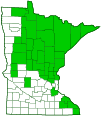prickly tree clubmoss
(Dendrolycopodium dendroideum)
Conservation • Wetland • Description • Habitat • Ecology • Use • Distribution • Taxonomy
Description |
||
Prickly tree clubmoss is a common low-growing plant of northern forests that looks like a miniature coniferous tree. It occurs in western Asia and North America. In the United States it occurs in the northern tier of states from Maine to Washington, and in the eastern half south to Missouri and North Carolina. In Canada it occurs in every province except Nunavut. In Minnesota it is common in the northeast, infrequent in the driftless area of the southeast, and mostly absent from the south and west. It grows in moist to dry, somewhat acidic, deciduous and mixed forests, and in shrubby areas recovering from fire or other disturbance. Prickly tree clubmoss is an erect, evergreen, perennial, tree clubmoss that rises from a long-creeping, horizontal stem (rhizome). The rhizome is subterranean, buried 2″ to 6″ (5 to 15 cm) below the soil surface. It has scattered, appressed, scale-like leaves. It does not have narrowed areas marking the start and end of each year’s growth (annual constrictions). It often forms large colonies. Upright shoots emerge at about 6″ intervals. They are erect, green, leafy, hairless, and much branched. They can be 4¾″ to 11¾″ (12 to 30 cm) tall but are usually no more than 6″ (15 cm) in height. The branches are themselves up to four times branched: most branches have two or more secondary branches (branchlets), those branchlets are usually branched, those branchlets are often branched, and those branchlets are sometimes branched. The branches and branchlets spread outwards, sometimes somewhat fan-like. The stem and branches are densely covered with prickly, needle-like leaves. Annual constrictions, if present, are inconspicuous. The leaves are arranged spirally in 6 ranks, two rows on top of the stem, two rows on the bottom, and one row on each side. All of the leaves are the same size and all spread. This leaf arrangement is important in distinguishing between this and similar club mosses. The leaves spread widely and curve upward at the tips. Leaves on the stem below the lowest branch are pale green, nearly horizontal (spreading), prickly to the touch, ⅛″ (3.5 to 4.0 mm) long, and 1 ⁄32″ (0.9 to 1.0 mm) wide. They are not twisted – the upper surface faces the stem. Leaves on the branches are pale green, spreading or curving upward from the base (ascending), stiff, 1 ⁄16″ to 3 ⁄16″(2.4 to 5.5 mm) long, and 1 ⁄64″ to 1 ⁄32″ (0.5 to 1.2 mm) wide. The tip is narrowly angled and does not have a hair-like extension. The margins are untoothed. Each fertile plant has 1 to 7 cone-like, spore-bearing structures (strobili). Each strobilus is stalkless at the tip of branchlet, narrowly cylinder-shaped, and ½″ to 2 3 ⁄16″ (12 to 55 mm) long. It is green at first, becoming tan at maturity. It is densely covered with small, scale-like bracts (sporophylls). Each sporophyll is broadly triangular, ⅛″ (3.0 to 3.5 mm) long and wide, and abruptly narrowed but without a hair-like extension at the tip. A single kidney-shaped spore-bearing structure (sporangia) is hidden beneath each sporophyll. |
||
Height |
||
4¾″ to 11¾″ (12 to 30 cm) |
||
Similar Species |
||
Habitat |
||
Moist to dry. Deciduous and mixed forests, successional shrubby areas. Acidic soil. |
||
Ecology |
||
Sporulation |
||
July to October |
||
Pests and Diseases |
||
|
||
Use |
||
|
||
Distribution |
||||
|
Sources |
|||
| 5/31/2023 | ||||
Nativity |
||||
Native |
||||
Occurrence |
||||
Common in northeastern Minnesota |
||||
Taxonomy |
|||
| Kingdom | Plantae (Plants) | ||
| Division | Tracheophyta (Vascular Plants) | ||
| Subdivision | Lycopodiophytina | ||
| Class | Lycopodiopsida | ||
| Subclass | Lycopodiidae | ||
Order |
Lycopodiales (clubmosses and firmosses) | ||
Family |
Lycopodiaceae (clubmosses and firmosses) | ||
| Subfamily | Lycopodioideae | ||
Genus |
Dendrolycopodium (tree-clubmosses) | ||
Until recently this plant was classified as Lycopodium obscurum. A morphological analysis (Hickey, 1977) showed that the species actually subsumed two separate species, one with two varieties. Following the study, Lycopodium dendroideum was recognized as a distinct species. Following a later analysis (Haines, 2003) of the anatomy, reproduction, and morphology in both the sporophyte and gametophyte stages, and number and appearance of chromosomes in the cell nuclei, Lycopodium was split into three genera. L. dendroideum was then transferred to the new genus Dendrolycopodium. |
|||
Subordinate Taxa |
|||
|
|||
Synonyms |
|||
Lycopodium dendroideum Lycopodium obscurum var. dendroideum Lycopodium obscurum var. hybridum |
|||
Common Names |
|||
prickle tree club-moss prickly tree clubmoss prickly tree-club-moss prickly tree club-moss round-branch clubmoss round-branch ground-pine tree groundpine |
|||
Glossary
Bract
Modified leaf at the base of a flower stalk, flower cluster, or inflorescence.
Rhizome
A horizontal, usually underground stem. It serves as a reproductive structure, producing roots below and shoots above at the nodes.
Sporangium
A spore bearing structure, as of a fern, moss, or slime mold. Plural: sporangia.
Sporophyll
A modified leaf that bears one or more sporangia.
Strobilus
A cone-like structure of horsetails (Equisetaceae) and clubmosses (Lycopodiaceae) composed of sporophylls densely arranged along a central axis. Plural: strobili.
Visitor Photos |
|||||
Share your photo of this plant. |
|||||
| This button not working for you? Simply email us at info@MinnesotaSeasons.com. Attach one or more photos and, if you like, a caption. |
|||||
Luciearl |
|||||
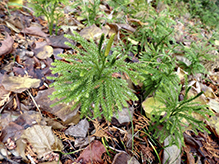 |
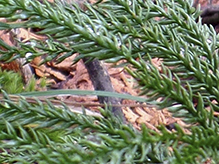 |
||||
MinnesotaSeasons.com Photos |
|||||
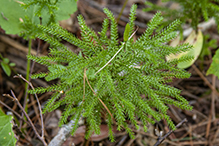 |
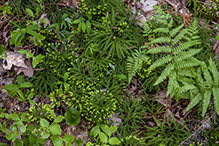 |
||||
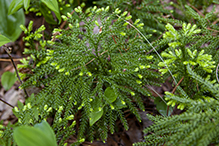 |
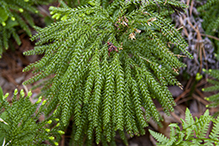 |
||||
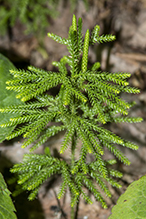 |
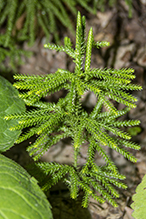 |
||||
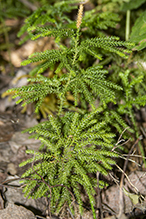 |
|||||

Slideshows |
||

Visitor Videos |
|||
Share your video of this plant. |
|||
| This button not working for you? Simply email us at info@MinnesotaSeasons.com. Attach a video, a YouTube link, or a cloud storage link. |
|||
Other Videos |
|||

Created: 11/11/2019
Last Updated:
